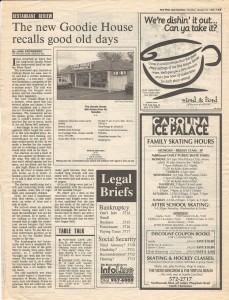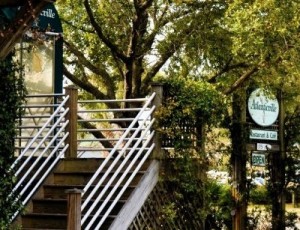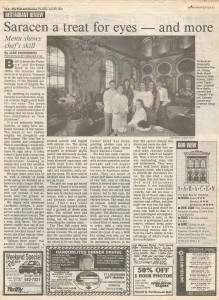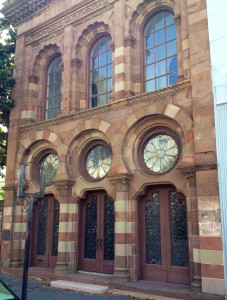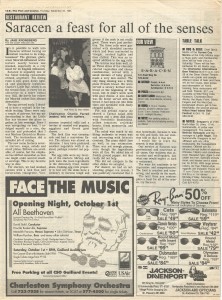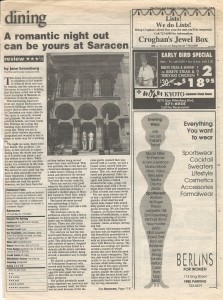FLASHBACK
We love our local restaurant community and have been keeping our fingers on the pulse for 70 years. One of our favorite past times is to read and collect the restaurant reviews found weekly inside The Post and Courier. Going back to the days of Peter Herman and Jane Kronsberg, we have hundreds of them that we love reading every so often and reliving some of our city’s past as it relates to food.
Since we love reading them so much, we thought it would be fun to share with our customers and community friends. As part of our new website redesign, we are excited to have a special section dedicated to showcasing the old reviews alongside a “where are they now” report. We will select a new review every week and post it. We will also have a fun update on the restaurant, the chef or even the menu as it is today as part of the recap. It is part of our “Flashback Fridays” and we hope you will enjoy.
FlashBack Fridays: The Goodie House 9.12.14
The Goodie House Review
January 22, 1998
Finding the Post and Courier restaurant review for the Goodie House unearthed memories of small cafes and shiny diners with round leather barstools, familiar faces, and other nostalgia from back when Charleston’s culinary scene was more like a quiet front porch than a global performance stage.
The original Goodie House many will recall was in a humble cottage-like structure on Calhoun Street. Now a Starbucks, the building sees throngs of visitors and College of Charleston students every day. While the exterior of the building has remained the same, much around it has been built up, sighting the college’s new multi-level science and arts buildings, and the recent tagging by artist Shepard Fairey of the dormitory across the street.
But before all of that, the Goodie House served comfort food to regulars, some of whom stopped in on a daily basis. Despite the modesty of the Goodie House, the chili, burgers, and especially the pies were “legendary,” to quote Jane Kronsberg, who reviewed the reincarnation of the Goodie House in 1998 at its Ashley River Road location.
During her late dinner (they arrive 45 minutes prior to closing time), Kronsberg summoned the famous burger and the pie. The wait staff was forthcoming that the hamburger had been cooked earlier in the day and warmed up for the late night service. As one would imagine, it was not stellar. And the pie? It was nowhere to be found, as they do not make pies at the end of the day because they don’t keep well overnight.
In today’s world of critic reviews, 24-hour and instant social media postings, restaurants can easily be pressured into performing well beyond their means or original intentions to please a handful of occasional patrons. The performance by the Goodie House on the night of Kronsberg’s review might seem by today’s standards detrimental or even incendiary; however, might it simply be that the Goodie House wanted to be authentically portrayed—no matter who was sitting at the counter?
Near the end of the write up, Kronsberg noted, “All in all, things were just as I had expected.” And isn’t that the charm and draw of diners and neighborhood cafés? They remain the same, they stay true to their original recipes, no matter what chatter or changes are taking place around them.
We hope our readers will find a moment to enjoy a neighborhood café or old fashion diner for what it is and ask nothing more. Or better yet, become a regular somewhere and experience the joy of seeing familiar faces behind the counter each time you go.
FlashBack Fridays: Through the Years at 14 North Market Street 8.22.14
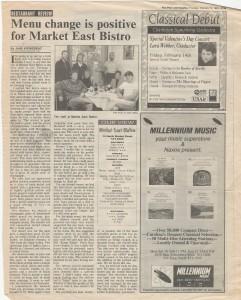 Charleston is a burgeoning town with a food industry to match. The city experiences a steady inhale and exhale of residents and visitors alike pining to partake in this culinary metropolis and driving the need for diverse options to quell their hunger.
Charleston is a burgeoning town with a food industry to match. The city experiences a steady inhale and exhale of residents and visitors alike pining to partake in this culinary metropolis and driving the need for diverse options to quell their hunger.
With this sentiment in mind, we searched through the old restaurant reviews from The Post and Courier. Among them we found the write up for Market East Bistro and were curious to uncover what types of establishments have occupied this location–14 North Market Street–over the years.
The review of Market East Bistro written by Jane Kronsberg ran on Thursday, February 13, 1997. This was Konsberg’s second review of the bistro since its opening, and she wrote fondly of her experience once again. The lunch and dinner selections highlighted the many seafood options available at this accessible but refined bistro. As one patron was quoted in the review, the food and service were good and the prices “extremely reasonable.”
After the closure of Market East Bistro, Vintage Restaurant and Wine Bar took over the spot. Owned by Kevin Kelley, who was also the wine director, the restaurant boasted hundreds of bottles to pair with Executive Chef Thomas Clayton’s Provencal-style cuisine. Contrary to many establishments in the neighborhood, Vintage did not showcase typical Lowcountry dishes, rather offering diners a taste of France.
Cordavi then took up residence at 14 N. Market. Turning the dial to fine dining, Cordavi became known as one of Charleston’s top restaurants in its opening year, earning Esquire magazine’s nod for Top 20 New Restaurants in 2006. The establishment was written about as a leader in sophisticated haute cuisine with the potential to launch Charleston onto the culinary scene with longtime cosmopolitan players. Described as a maverick in the local dining scene, Cordavi showcased cutting edge culinary arts and was unapologetically “un-Southern,” regularly calling international ingredients to the table. Perhaps with the same surprise invoked by its creative approach, Cordavi closed leaving many lamenting a too-short stay. Read more about Cordavi in the City Paper review by writer Jeff Allen.
Another 14 N. Market Street establishment was Gilligan’s Seafood Restaurant. Gilligan’s, a family-friendly casual spot, brought a fun and lively atmosphere to the historical market and served as great place for traveling groups to dine. The bar at Gilligan’s stayed open well into the night, hosting late-night revelers in search of an affordable good time.
And finally, Burwell’s Stone Fire Grill is the current resident of 14 N. Market Street. An expansive establishment, the owners exposed the hidden history of the space by removing drywall to reveal 1800s-era cypress walls, paying homage to Market Street’s rich past. Bringing a modern twist to the traditional steakhouse, Burwell’s uses a 1,400 degree wood-fire grill and is promising an experience divergent from the overly masculine characteristics common of steakhouses. Read more about Burwell’s in this write up in the City Paper.
Looking back on the many restaurants that once called 14 N. Market Street home, we see a wide spectrum of culinary approaches. And with the diversity of palates in Charleston, coming from world travelers, vacationing families, long-time locals, and new residents, we are sure there is a place for just as many restaurant styles, themes, and cuisines and look forward to what the future might bring.
FlashBack Fridays: Then and Now at 2063 Middle Street 7.18.14
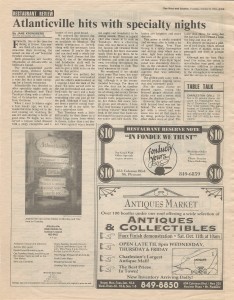 Atlanticville, located at 2063 Middle Street, was a Sullivan’s Island institution for 22 years. Now only a memory, we wanted to revisit the reputation of the restaurant and explore its lasting impact on the Sullivan’s Island culinary scene by digging up its review and reaching out to the new residents of 2063 Middle Street.
Atlanticville, located at 2063 Middle Street, was a Sullivan’s Island institution for 22 years. Now only a memory, we wanted to revisit the reputation of the restaurant and explore its lasting impact on the Sullivan’s Island culinary scene by digging up its review and reaching out to the new residents of 2063 Middle Street.
The Post and Courier’s Food Critic Jane Kronsberg reviewed the restaurant on October 9, 1997. Highlighting the establishment’s view and comfortable porch seating, Kronsberg noted the pleasantries of outdoor dining in Charleston during the fall. Atlanticville set itself apart from its island neighbors by steering away from the typical overly casual beach atmosphere and unsophisticated menu. Upon opening, the late Chef Phil Corr was at the helm. He took a risk gambling on the notion that beachgoers would find respite from sun and sand inside his relatively upscale accommodations and be drawn to his integration of locally sourced ingredients.
It was a wager that worked. A sister publication of USA Today, The 10Best wrote, “Exceptional cuisine is the hallmark of this relaxed Sullivan’s Island restaurant, and awards rain constantly upon its chef and kitchen.” General Manager Andrew Harris stepped in for the last part of Atlanticville’s two-decade reign and continued to honor Corr’s culinary passion.
In 2012 the restaurant closed for what was to be a period of renovation; however, it never reopened and shuttered for good later that summer. While Atlanticville may be closed for ever, it raised the bar on island cuisine, laying a foundation for further refinement of this culinary genre.
Not long after its closure, whispers of what would replace Atlanticville began to circulate within the industry, growing louder when the owner of Wild Olive Restaurant Group sought permitting for Sullivan’s Island. Soon enough, it was announced that Chef Jacques Larson and the Wild Olive Restaurant Group would open a new venture at 2063 Middle Street.
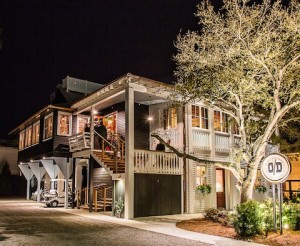 On March 19, 2014, The Obstinate Daughter opened for business. According to the restaurant’s website, the name comes from Revolutionary War history on Sullivan’s Island. In 1776, defenders of Fort Sullivan saved the island from British capture during the Battle of Sullivan’s Island. It was this act that “inspired a London political cartoon of the defiant defenders of Charleston: “Miss Carolina Sulivan, one of the obstinate daughters of America, 1776”.”
On March 19, 2014, The Obstinate Daughter opened for business. According to the restaurant’s website, the name comes from Revolutionary War history on Sullivan’s Island. In 1776, defenders of Fort Sullivan saved the island from British capture during the Battle of Sullivan’s Island. It was this act that “inspired a London political cartoon of the defiant defenders of Charleston: “Miss Carolina Sulivan, one of the obstinate daughters of America, 1776”.”
Calling itself a “Food Fort,” the restaurant boasts Southern cuisine with French, Italian, and Spanish influences. It is progressive in its offerings and business approach, seeking a Green Restaurant Certification. The Obstinate Daughter has decidedly upped the ante on island dining. And we’re not the only ones who think so. Writer Robert Moss in a write up for the Charleston City Paper noted the establishment has “the right formula to round out a revitalized beach dining scene.”
While Charleston and its surrounding islands are certainly in the midst of a culinary awakening, this current movement was surely sparked by the restaurants and chefs of yesteryear. One cannot deny that Atlanticville’s gamble may have incited the desire for more urbane fare on this barrier island.
 When asking Chef Larson about his influences for the new restaurant, we wondered if Atlanticville may have played a part.
When asking Chef Larson about his influences for the new restaurant, we wondered if Atlanticville may have played a part.
Larson: Having moved to Charleston in 1996, I was quite familiar with Atlanticville restaurant and more specifically, Phil Corr. Phil was a “chef’s chef.” His hard work ethic and passion for food mixed with a great sense of humor made him a local favorite. He was also an early advocate of sourcing things locally. After the sad loss of Phil to lung cancer, Andrew Harris took the torch at Atlanticville, and I would most certainly say that he embodied the same drive for hospitality excellence that Phil strove to achieve.
These factors have had a direct influence on what we set out to accomplish on Sullivan’s Island. Focusing on using local products, building genuine relationships with guests and delivering high quality food and service in a comfortable, yet polished setting. [This] is still the same goal at 2063 Middle St.
The Obstinate Daughter’s Revolutionary War-inspired motif reflects its revolutionary ideologies about beach cuisine. We hope this “Food Fort” defends its stay on Sullivan’s Island—much like its stubborn influencer, Miss Carolina Sulivan— for years to come, and that it continues to carry on so beautifully the hospitality and passion of the chefs and staff who came before.
FlashBack Fridays: Center Street and East Arctic Avenue, Folly Beach 7.4.14
FlashBack Fridays: Center Street and East Arctic Avenue, Folly Beach
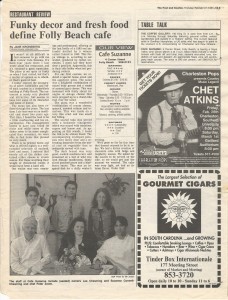 It’s the 4th of July, and in the Lowcountry, that means almost everyone is headed to the beach. In honor of the holiday, we sifted through our collection of reviews to find a beachside eatery that surely would have been abuzz with patrons celebrating America’s independence.
It’s the 4th of July, and in the Lowcountry, that means almost everyone is headed to the beach. In honor of the holiday, we sifted through our collection of reviews to find a beachside eatery that surely would have been abuzz with patrons celebrating America’s independence.
Folly Beach, known as the Edge of America, has seen more than its fair share of restaurants and bars through the years. Like Folly’s swirl of locals, day-trippers, and transient residents, restaurants here are eclectic and seem to ebb and flow with the tide. On one particular corner of the island’s main district, the corner of Center Street and East Arctic, sat Café Suzanne.
Jane Kronsberg first reviewed Café Suzanne in 1994, and revisited for a second taste in 1997. She described the restaurant as having a good reputation and funky flare fit for Folly Beach. When looking into the restaurant’s location, we dreamily wondered what may have come before Café Suzanne. We discovered a history of offbeat inhabitants reflective of the beach town’s shifting shoreline and culture of frivolity.
In the 1920s, The Folly Pier and Pavilion occupied the spot where Center Street and East Arctic converge. This was back when Arctic Street looked akin to Coney Island, boasting its own Ferris wheel, among other amusements. The Pavilion was later transformed into the Dancing Bear, Folly Beach’s own bowling alley, and later into a bar named Monk’s Corner.
More recently, The Terrapin Café took up residency here. Writer Jeff Allen reviewed the spot 11 years after Kronsberg’s visit to Café Suzanne. Allen was not keen on the cuisine, but acquiesced that the island’s constant parade of motley beach-goers might find their place at the table here (or on its dark dance floor post sunset).
Perhaps caught in the outgoing tide of tourists, trekkers, and beach bums, The Terrapin Café eventually shuttered to make way for another hopeful restaurateur. Rita’s Seaside Grille now sits proudly at the corner of Center and East Arctic, and, as the décor demands, is reminiscent of the days long before The Terrapin, Café Suzanne, and the Dancing Bear. Rita’s invokes memories of the boardwalk carnival era when the Pavilion was the main attraction and everyone was dancing to the sounds of The Beach Boys. Allen also reviewed Rita’s, and in his 2009 write-up suggested that the establishment might kindle a shift in food culture on the island. Five years have since passed, and while Folly Beach—true to its nature—has been slow to change, Rita’s has kept a stronghold on this corner.
We are certain on this 4th of July that Folly Beach and its many restaurants will be brimming with the same eclectic patrons it has always welcomed, and we look forward to seeing what washes up next for this quaint and curious beach community.
FlashBack Fridays: Saracen’s Reviews 6.27.14
Saracen Reviews: April 22, 1992; September 22, 1994; and November 12, 1998
Saracen was well known for its lush interior, described on several occasions as a “feast for the eyes.” Located at 141 East Bay Street in Charleston, SC, the restaurant occupied the Farmer’s and Exchange Bank building, a structure equally known for its appearance and brush with fate.
Before Owner and Chef Charlie Farrell opened Saracen in 1990, the building served as office space for Sen. Fritz Hollings and was nearly demolished to make way for parking. Saved in 1970, the building was restored and added to the list of National Historic Landmarks in 1973.
The building’s architecture, Moorish and Spanish in style, is rare in the Holy City; this uniqueness nicely complemented the unexpected cuisine one would find inside.
Former Post and Courier restaurant critic Jane Kronsberg reviewed Saracen on three occasions, in 1992, ’94, and ’98, detailing a pleasant experience each time. The cuisine featured Mediterranean and Asian ingredients and was described as new American with Middle Eastern flavor. Like many restaurants of today, the menu at Saracen was small and changed regularly utilizing seasonal produce.
Highlights of the menu included dishes like “salmon three ways,” chilled beet and grapefruit soup, Thai fish cakes, shrimp and pork egg rolls, apple and potato crusted trout cake, and coffee-rubbed quail. Saracen presented unique dishes including Cioppino, an Italian-American fish stew, and quenelles, creamed fish or meat combined with bread crumbs and light egg binding, a dish not often served in American establishments.
Chef Farrell also infused Moroccan, Vietnamese, and Caribbean spices into his dishes creating a menu of eclectic offerings over the years.
The establishment’s second floor was home to Charlie’s Little Bar (named for Farrell) and echoed the Moorish architecture, luxury, and comfort of the first-floor dining area. Kronsberg reported that the Little Bar attracted big crowds out for late weekend nights.
The décor at Saracen, Kronsberg noted, provided a romantic atmosphere reminiscent of the mystery and magic conjured by stories of Arabian Nights. She described the restaurant as luxurious, glamorous, and “one of the best-looking restaurants around.” One last note, Kronsberg ranked Saracen’s decibel level at “quiet,” and in light of a recent Post and Courier report on restaurant noise, such a tranquil dining experience might be—like the Saracen—a thing of the past.
The building that housed Saracen for many years now stands vacant, hosting special events from time to time. We hope that a place this special and with so much history will once again come to life as some sort of amazing culinary gem for the city.

